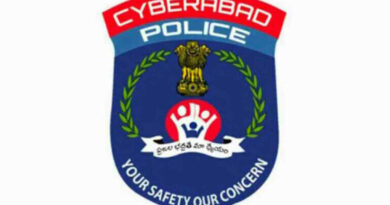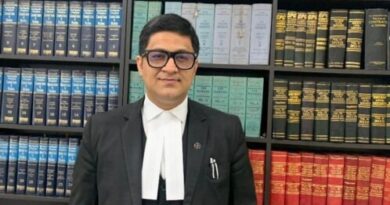Telangana High Court Issues Notice to State on a PIL Challenging Use of Facial Recognition Technology with Out Support of Law.
(Judicial Quest News Network)
The Telangana High Court today issued a notice to the State of Telangana on a plea Challenging use of Facial Recognition Technology (FRT) by state and Telangana Police with out a valid law supporting the (FRT) [SQ Masood vs State of Telangana].
The notice has been issued by a bench of Chief Justice Satish Sharma and Abhinand Kumar Shivali on the PIL filed by a social activist from Hyderabad. S.Q.Masood, arguing that the deployment of FRT is not backed by law, is unnecessary, disproportionate, and is being done without any safeguard in place to prevent misuse. The matter is listed for further hearing on Januar,15.
The petitioner in petition raises the apprehensions that he was subject to FRT.
This particular apprehension arose when on 19th May 2021, Mr S.Q. Masood, a prominent social activist and a consultant at several NGOs, was stopped by 8-10 police officers in Hyderabad while he was returning home from work. They directed him to remove his mask even though the pandemic was ongoing, and Hyderabad was reporting a large number of cases.
They did so because they wanted to take his photograph. Mr. Masood refused but they captured his picture anyway. Concerned with how his picture may be used, and to find out the legal basis of the actions of the police officers, Mr. Masood addressed a legal notice to the Police Commissioner of Hyderabad with legal support from IFF.
He did not receive any answer, but he decided to investigate further as he was concerned that the picture was taken for facial recognition.
It was also clarified that the plea relied on news reports because the respondents had failed to provide information regarding the use and implementation of FRT in public domain and also declined to provide such details in response to Right to Information Application.
It is further submitted that the Telangana Police’s unfettered use of FRT was violative of the fundamental right to privacy since it was not backed by a law.
The petitioner relied upon the judgement of the Supreme Court in KS Puttu Swamy Vs Union of India to back this argument.
The PIL (drawn with legal assistance provided by the Internet Freedom Foundation) states that Telangana is the most surveilled place in the world, and the State Government had been deploying Facial Recognition Technology (FRT) without any legal basis for a range of purposes including but not limited to law enforcement, supplying essential services and elections.
FRT refers to a technology that involves processing images of individual faces for verification or identification of individuals by extracting data points from a face to create a template and then comparing it with an existing database. Verification is done by matching the live photograph of a person to the pre-existing photograph that is on the authority’s database (1:1). Identification is done by matching the photograph of an individual with the pictures in the database of the authority to ascertain the identity of the individual (1:many). FRT systems generate a probability match score or a confidence score between the suspect who is to be identified and the database of identified criminals that the Police has access to already (for eg. the Crime and Criminal Tracking Network System). Multiple possible matches are generated and listed based on their likelihood to be the correct match with corresponding confidence scores. The final identification, however, is usually done by the human analyst who selects one match from the list of matches generated by the technology. This identification procedure is ripe for misidentification because while the software releases several possible matches, the analyst conducting the search makes the final identification. This also opens the door for the analyst’s own biases to creep into the final result wherein they may be prejudiced against a certain race, religion or community, based on which their decision making may be affected.
FRT refers to a technology that involves processing images of individual faces for verification or identification of individuals by extracting data points from a face to create a template and then comparing it with an existing database. Verification is done by matching the live photograph of a person to the pre-existing photograph that is on the authority’s database (1:1). Identification is done by matching the photograph of an individual with the pictures in the database of the authority to ascertain the identity of the individual (1: many). FRT systems generate a probability match score or a confidence score between the suspect who is to be identified and the database of identified criminals that the Police has access to already (for e.g., the Crime and Criminal Tracking Network System). Multiple possible matches are generated and listed based on their likelihood to be the correct match with corresponding confidence scores. The final identification, however, is usually done by the human analyst who selects one match from the list of matches generated by the technology. This identification procedure is ripe for misidentification because while the software releases several possible matches, the analyst conducting the search makes the final identification. This also opens the door for the analyst’s own biases to creep into the final result wherein they may be prejudiced against a certain race, religion or community, based on which their decision making may be affected.
According to news reports, the Telangana Police has been deploying FRT across the State of Telangana in the form of FRT enabled-CCTV Cameras which enable mass identification of individuals in real-time. To that end, the State of Telangana has installed 5,80,000 CCTV cameras in public spaces.
Apart from FRT enabled-CCTV cameras, the State of Telangana has also provided tablets/mobile phones to police officers on the ground which have the ‘TSCOP’ application. The application allows these officers to take a photograph and seek a match with an existing database. The images captured either on CCTV or through the TSCOP application are compared with the Crime and Criminal Tracking Network System database maintained by the Ministry of Home Affairs as well as other databases maintained by the State of Telangana.
As of date, no information is available in the public domain regarding the accuracy levels of either the FRT enabled CCTV Cameras or the FRT deployed TSCOP application. Worryingly, there also isn’t a law that governs on whom the police may deploy FRT or where they may deploy FRT or for what purposes they may do so.
There also isn’t a law that governs how the data obtained through FRT may be stored, retained and used. Even more worryingly, the State of Telangana has refused to reveal the legal basis of the deployment of FRT or their accuracy levels in response to a right to information application filed by IFF.
However, the PIL adds, in the State of Telangana, no law empowers the executive of the deployment, and considering that most FRT technologies are inaccurate, such deployment is not suitable to achieve any objective.
Therefore, apart from a direction to prohibit the use of FRT for any purpose, the petitioner also sought an interim order to suspend the use of the technology pending the disposal of the petition
Advocate Manoj Reddy represented the petitioner.




